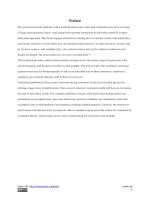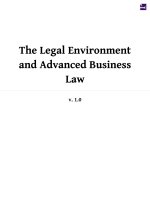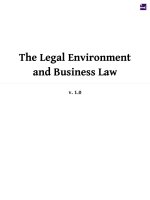Advanced business law and the legal environment
Bạn đang xem bản rút gọn của tài liệu. Xem và tải ngay bản đầy đủ của tài liệu tại đây (12.33 MB, 1,303 trang )
This text was adapted by The Saylor Foundation under a Creative
Commons Attribution-NonCommercial-ShareAlike 3.0 License without
attribution as requested by the work’s original creator or licensee.
Saylor URL: />
Saylor.org
1
Preface
Our goal is to provide students with a textbook that is up to date and comprehensive in its coverage of
legal and regulatory issues—and organized to permit instructors to tailor the materials to their particular
approach. This book engages students by relating law to everyday events with which they are already
familiar (or with which they are familiarizing themselves in other business courses) and by its clear,
concise, and readable style. (An earlier business law text by authors Lieberman and Siedel was hailed “the
best written text in a very crowded field.”)
This textbook provides context and essential concepts across the entire range of legal issues with which
managers and business executives must grapple. The text provides the vocabulary and legal acumen
necessary for businesspeople to talk in an educated way to their customers, employees, suppliers,
government officials—and to their own lawyers.
Traditional publishers often create confusion among customers in the text selection process by offering a
huge array of publications. Once a text is selected, customers might still have to customize the text to meet
their needs. For example, publishers usually offer books that include either case summaries or excerpted
cases, but some instructors prefer to combine case summaries with a few excerpted cases so that students
can experience reading original material. Likewise, the manner in which most conventional texts
incorporate video is cumbersome because the videos are contained in a separate library, which makes
access more complicating for instructors and students.
This model eliminates the need for “families” of books (such as the ten Miller texts mentioned below) and
greatly simplifies text selection. Instructors have only to select between our Business Law and Legal
Environment volumes of the text and then click on the features they want (as opposed to trying to
compare the large number of texts and packages offered by other publishers). In addition to the features
inherent in any publication, this book offers these unique features:
• Cases are available in excerpted and summarized format, thus enabling instructors to easily “mix and
match” excerpted cases with case summaries.
• Links to forms and uniform laws are embedded in the text. For example, the chapters on contract law
incorporate discussion of various sections of the Uniform Commercial Code, which is available
at />
Saylor URL: />
Saylor.org
2
• Likewise, many sample legal forms are readily available online. For example, the chapter on
employment law refers to the type of terms commonly found in a standard employment agreement,
examples of which can be found at />• Every chapter contains overviews that include the organization and coverage, a list of key terms, chapter
summaries, and self-test questions in multiple-choice format (along with answers) that are followed by
additional problems with answers available in the Instructors’ Manual.
• In addition to standard supplementary materials offered by other texts, students have access to
electronic flash cards, proactive quizzes, and audio study guides.
Saylor URL: />
Saylor.org
3
Chapter 1
Introduction to Law and Legal Systems
L EA R N IN G O B JEC T IV ES
After reading this chapter, you should be able to do the following:
1. Distinguish different philosophies of law—schools of legal thought—and explain their
relevance.
2. Identify the various aims that a functioning legal system can serve.
3. Explain how politics and law are related.
4. Identify the sources of law and which laws have priority over other laws.
5. Understand some basic differences between the US legal system and other legal
systems.
Law has different meanings as well as different functions. Philosophers have considered issues of justice
and law for centuries, and several different approaches, or schools of legal thought, have emerged. In this
chapter, we will look at those different meanings and approaches and will consider how social and
political dynamics interact with the ideas that animate the various schools of legal thought. We will also
look at typical sources of “positive law” in the United States and how some of those sources have priority
over others, and we will set out some basic differences between the US legal system and other legal
systems.
Saylor URL: />
Saylor.org
4
1.1 What Is Law?
Law is a word that means different things at different times. Black’s Law Dictionary says that law is “a
body of rules of action or conduct prescribed by controlling authority, and having binding legal force. That
which must be obeyed and followed by citizens subject to sanctions or legal consequence is a law.”
[1]
Functions of the Law
In a nation, the law can serve to (1) keep the peace, (2) maintain the status quo, (3) preserve individual
rights, (4) protect minorities against majorities, (5) promote social justice, and (6) provide for orderly
social change. Some legal systems serve these purposes better than others. Although a nation ruled by an
authoritarian government may keep the peace and maintain the status quo, it may also oppress minorities
or political opponents (e.g., Burma, Zimbabwe, or Iraq under Saddam Hussein). Under colonialism,
European nations often imposed peace in countries whose borders were somewhat arbitrarily created by
those same European nations. Over several centuries prior to the twentieth century, empires were built by
Spain, Portugal, Britain, Holland, France, Germany, Belgium, and Italy. With regard to the functions of
the law, the empire may have kept the peace—largely with force—but it changed the status quo and
seldom promoted the native peoples’ rights or social justice within the colonized nation.
In nations that were former colonies of European nations, various ethnic and tribal factions have
frequently made it difficult for a single, united government to rule effectively. In Rwanda, for example,
power struggles between Hutus and Tutsis resulted in genocide of the Tutsi minority. (Genocide is the
deliberate and systematic killing or displacement of one group of people by another group. In 1948, the
international community formally condemned the crime of genocide.) In nations of the former Soviet
Union, the withdrawal of a central power created power vacuums that were exploited by ethnic leaders.
When Yugoslavia broke up, the different ethnic groups—Croats, Bosnians, and Serbians—fought bitterly
for home turf rather than share power. In Iraq and Afghanistan, the effective blending of different groups
of families, tribes, sects, and ethnic groups into a national governing body that shares power remains to be
seen.
Saylor URL: />
Saylor.org
5
Law and Politics
In the United States, legislators, judges, administrative agencies, governors, and presidents make law,
with substantial input from corporations, lobbyists, and a diverse group of nongovernment organizations
(NGOs) such as the American Petroleum Institute, the Sierra Club, and the National Rifle Association. In
the fifty states, judges are often appointed by governors or elected by the people. The process of electing
state judges has become more and more politicized in the past fifteen years, with growing campaign
contributions from those who would seek to seat judges with similar political leanings.
In the federal system, judges are appointed by an elected official (the president) and confirmed by other
elected officials (the Senate). If the president is from one party and the other party holds a majority of
Senate seats, political conflicts may come up during the judges’ confirmation processes. Such a division
has been fairly frequent over the past fifty years.
In most nation-states (as countries are called in international law), knowing who has power to make
and enforce the laws is a matter of knowing who has political power; in many places, the people or groups
that have military power can also command political power to make and enforce the laws. Revolutions are
difficult and contentious, but each year there are revolts against existing political-legal authority; an
aspiration for democratic rule, or greater “rights” for citizens, is a recurring theme in politics and law.
K E Y TA K EA WAY
Law is the result of political action, and the political landscape is vastly different from
nation to nation. Unstable or authoritarian governments often fail to serve the principal
functions of law.
Saylor URL: />
Saylor.org
6
E XE R C IS ES
1. Consider Burma (named Myanmar by its military rulers). What political rights do you
have that the average Burmese citizen does not?
2. What is a nongovernment organization, and what does it have to do with government?
Do you contribute to (or are you active in) a nongovernment organization? What kind of
rights do they espouse, what kind of laws do they support, and what kind of laws do they
oppose?
[1] Black’s Law Dictionary, 6th ed., s.v. “law.”
Saylor URL: />
Saylor.org
7
1.2 Schools of Legal Thought
LEARN ING OB JECTIVES
1. Distinguish different philosophies of law—schools of legal thought—and explain
their relevance.
2. Explain why natural law relates to the rights that the founders of the US politicallegal system found important.
3. Describe legal positivism and explain how it differs from natural law.
4. Differentiate critical legal studies and ecofeminist legal perspectives from both
natural law and legal positivist perspectives.
There are different schools (or philosophies) concerning what law is all about. Philosophy of law is also
called jurisprudence, and the two main schools are legal positivism and natural law. Although
there are others (see Section 1.2.3 "Other Schools of Legal Thought"), these two are the most influential in
how people think about the law.
Legal Positivism: Law as Sovereign Command
As legal philosopher John Austin concisely put it, “Law is the command of a sovereign.” Law is only law,
in other words, if it comes from a recognized authority and can be enforced by that authority,
or sovereign—such as a king, a president, or a dictator—who has power within a defined area or
territory. Positivism is a philosophical movement that claims that science provides the only knowledge
precise enough to be worthwhile. But what are we to make of the social phenomena of laws?
We could examine existing statutes—executive orders, regulations, or judicial decisions—in a fairly
precise way to find out what the law says. For example, we could look at the posted speed limits on most
US highways and conclude that the “correct” or “right” speed is no more than fifty-five miles per hour. Or
we could look a little deeper and find out how the written law is usually applied. Doing so, we might
conclude that sixty-one miles per hour is generally allowed by most state troopers, but that occasionally
someone gets ticketed for doing fifty-seven miles per hour in a fifty-five miles per hour zone. Either
Saylor URL: />
Saylor.org
8
approach is empirical, even if not rigorously scientific. The first approach, examining in a precise way
what the rule itself says, is sometimes known as the “positivist” school of legal thought. The second
approach—which relies on social context and the actual behavior of the principal actors who enforce the
law—is akin to the “legal realist” school of thought (see Section 1.2.3 "Other Schools of Legal Thought").
Positivism has its limits and its critics. New Testament readers may recall that King Herod, fearing the
birth of a Messiah, issued a decree that all male children below a certain age be killed. Because it was the
command of a sovereign, the decree was carried out (or, in legal jargon, the decree was “executed”).
Suppose a group seizes power in a particular place and commands that women cannot attend school and
can only be treated medically by women, even if their condition is life-threatening and women doctors are
few and far between. Suppose also that this command is carried out, just because it is the law and is
enforced with a vengeance. People who live there will undoubtedly question the wisdom, justice, or
goodness of such a law, but it is law nonetheless and is generally carried out. To avoid the law’s impact, a
citizen would have to flee the country entirely. During the Taliban rule in Afghanistan, from which this
example is drawn, many did flee.
The positive-law school of legal thought would recognize the lawmaker’s command as legitimate;
questions about the law’s morality or immorality would not be important. In contrast, the natural-law
school of legal thought would refuse to recognize the legitimacy of laws that did not conform to natural,
universal, or divine law. If a lawmaker issued a command that was in violation of natural law, a citizen
would be morally justified in demonstrating civil disobedience. For example, in refusing to give up her
seat to a white person, Rosa Parks believed that she was refusing to obey an unjust law.
Natural Law
The natural-law school of thought emphasizes that law should be based on a universal moral order.
Natural law was “discovered” by humans through the use of reason and by choosing between that which is
good and that which is evil. Here is the definition of natural law according to the Cambridge Dictionary of
Philosophy: “Natural law, also called the law of nature in moral and political philosophy, is an objective
Saylor URL: />
Saylor.org
9
norm or set of objective norms governing human behavior, similar to the positive laws of a human ruler,
but binding on all people alike and usually understood as involving a superhuman legislator.”
[1]
Both the US Constitution and the United Nations (UN) Charter have an affinity for the natural-law
outlook, as it emphasizes certain objective norms and rights of individuals and nations. The US
Declaration of Independence embodies a natural-law philosophy. The following short extract should
provide some sense of the deep beliefs in natural law held by those who signed the document.
The Unanimous Declaration of the Thirteen United States of America
July 4, 1776
When in the Course of human events, it becomes necessary for one people to dissolve the political bands
which have connected them with another, and to assume among the powers of the earth, the separate and
equal station to which the Laws of Nature and of Nature’s God entitle them, a decent respect to the
opinions of mankind requires that they should declare the causes which impel them to the separation.
We hold these truths to be self-evident, that all men are created equal, that they are endowed by their
Creator with certain unalienable Rights, that among these are Life, Liberty and the Pursuit of Happiness.
That to secure these rights, Governments are instituted among Men, deriving their just powers from the
consent of the governed.…
The natural-law school has been very influential in American legal thinking. The idea that certain rights,
for example, are “unalienable” (as expressed in the Declaration of Independence and in the writings of
John Locke) is consistent with this view of the law. Individuals may have “God-given” or “natural” rights
that government cannot legitimately take away. Government only by consent of the governed is a natural
outgrowth of this view.
Civil disobedience—in the tradition of Henry Thoreau, Mahatma Gandhi, or Martin Luther King Jr.—
becomes a matter of morality over “unnatural” law. For example, in his “Letter from Birmingham Jail,”
Martin Luther King Jr. claims that obeying an unjust law is not moral and that deliberately disobeying an
Saylor URL: />
Saylor.org
10
unjust law is in fact a moral act that expresses “the highest respect for law”: “An individual who breaks a
law that conscience tells him is unjust, and who willingly accepts the penalty of imprisonment in order to
arouse the conscience of the community over its injustice, is in reality expressing the highest respect for
law.…One who breaks an unjust law must do so openly, lovingly, and with a willingness to accept the
penalty.”
[2]
Legal positivists, on the other hand, would say that we cannot know with real confidence what “natural”
law or “universal” law is. In studying law, we can most effectively learn by just looking at what the written
law says, or by examining how it has been applied. In response, natural-law thinkers would argue that if
we care about justice, every law and every legal system must be held accountable to some higher standard,
however hard that may be to define.
It is easier to know what the law “is” than what the law “should be.” Equal employment laws, for example,
have specific statutes, rules, and decisions about racial discrimination. There are always difficult issues of
interpretation and decision, which is why courts will resolve differing views. But how can we know the
more fundamental “ought” or “should” of human equality? For example, how do we know that “all men
are created equal” (from the Declaration of Independence)? Setting aside for the moment questions about
the equality of women, or that of slaves, who were not counted as men with equal rights at the time of the
declaration—can the statement be empirically proven, or is it simply a matter of a priori knowledge? (A
priori means “existing in the mind prior to and independent of experience.”) Or is the statement about
equality a matter of faith or belief, not really provable either scientifically or rationally? The dialogue
between natural-law theorists and more empirically oriented theories of “what law is” will raise similar
questions. In this book, we will focus mostly on the law as it is, but not without also raising questions
about what it could or should be.
Other Schools of Legal Thought
The historical school of law believes that societies should base their legal decisions today on the examples
of the past. Precedent would be more important than moral arguments.
Saylor URL: />
Saylor.org
11
The legal realist school flourished in the 1920s and 1930s as a reaction to the historical school. Legal
realists pointed out that because life and society are constantly changing, certain laws and doctrines have
to be altered or modernized in order to remain current. The social context of law was more important to
legal realists than the formal application of precedent to current or future legal disputes. Rather than
suppose that judges inevitably acted objectively in applying an existing rule to a set of facts, legal realists
observed that judges had their own beliefs, operated in a social context, and would give legal decisions
based on their beliefs and their own social context.
The legal realist view influenced the emergence of the critical legal studies (CLS) school of thought. The
“Crits” believe that the social order (and the law) is dominated by those with power, wealth, and influence.
Some Crits are clearly influenced by the economist Karl Marx and also by distributive justice theory
(see Chapter 2 "Corporate Social Responsibility and Business Ethics"). The CLS school believes the
wealthy have historically oppressed or exploited those with less wealth and have maintained social control
through law. In so doing, the wealthy have perpetuated an unjust distribution of both rights and goods in
society. Law is politics and is thus not neutral or value-free. The CLS movement would use the law to
overturn the hierarchical structures of domination in the modern society.
Related to the CLS school, yet different, is the ecofeminist school of legal thought. This school
emphasizes—and would modify—the long-standing domination of men over both women and the rest of
the natural world. Ecofeminists would say that the same social mentality that leads to exploitation of
women is at the root of man’s exploitation and degradation of the natural environment. They would say
that male ownership of land has led to a “dominator culture,” in which man is not so much a steward of
the existing environment or those “subordinate” to him but is charged with making all that he controls
economically “productive.” Wives, children, land, and animals are valued as economic resources, and legal
systems (until the nineteenth century) largely conferred rights only to men with land. Ecofeminists would
say that even with increasing civil and political rights for women (such as the right to vote) and with some
nations’ recognizing the rights of children and animals and caring for the environment, the legacy of the
past for most nations still confirms the preeminence of “man” and his dominance of both nature and
women.
Saylor URL: />
Saylor.org
12
K E Y TA K EA WAY
Each of the various schools of legal thought has a particular view of what a legal system
is or what it should be. The natural-law theorists emphasize the rights and duties of both
government and the governed. Positive law takes as a given that law is simply the
command of a sovereign, the political power that those governed will obey. Recent
writings in the various legal schools of thought emphasize long-standing patterns of
domination of the wealthy over others (the CLS school) and of men over women
(ecofeminist legal theory).
E XE R C IS ES
1. Vandana Shiva draws a picture of a stream in a forest. She says that in our society the
stream is seen as unproductive if it is simply there, fulfilling the need for water of
women’s families and communities, until engineers come along and tinker with it,
perhaps damming it and using it for generating hydropower. The same is true of a forest,
unless it is replaced with a monoculture plantation of a commercial species. A forest may
very well be productive—protecting groundwater; creating oxygen; providing fruit, fuel,
and craft materials for nearby inhabitants; and creating a habitat for animals that are
also a valuable resource. She criticizes the view that if there is no monetary amount that
can contribute to gross domestic product, neither the forest nor the river can be seen as
a productive resource. Which school of legal thought does her criticism reflect?
2. Anatole France said, “The law, in its majesty, forbids rich and poor alike from sleeping
under bridges.” Which school of legal thought is represented by this quote?
3. Adolf Eichmann was a loyal member of the National Socialist Party in the Third Reich and
worked hard under Hitler’s government during World War II to round up Jewish people
for incarceration—and eventual extermination—at labor camps like Auschwitz and
Buchenwald. After an Israeli “extraction team” took him from Argentina to Israel, he was
put on trial for “crimes against humanity.” His defense was that he was “just following
Saylor URL: />
Saylor.org
13
orders.” Explain why Eichmann was not an adherent of the natural-law school of legal
thought.
[1] Cambridge Dictionary of Philosophy, s.v. “natural law.”
[2] Martin Luther King Jr., “Letter from Birmingham Jail.”
Saylor URL: />
Saylor.org
14
1.3 Basic Concepts and Categories of US Positive Law
L EA R N IN G O B JEC T IV ES
1. In a general way, differentiate contract law from tort law.
2. Consider the role of law in supporting ethical norms in our society.
3. Understand the differing roles of state law and federal law in the US legal system.
4. Know the difference between criminal cases and civil cases.
Most of what we discuss in this book is positive law—US positive law in particular. We will also consider
the laws and legal systems of other nations. But first, it will be useful to cover some basic concepts and
distinctions.
Law: The Moral Minimums in a Democratic Society
The law does not correct (or claim to correct) every wrong that occurs in society. At a minimum, it aims to
curb the worst kind of wrongs, the kinds of wrongs that violate what might be called the “moral
minimums” that a community demands of its members. These include not only violations of criminal law
(see Chapter 6 "Criminal Law") but also torts (see Chapter 7 "Introduction to Tort Law") and broken
promises (see (Reference mayer_1.0-ch08 not found in Book)). Thus it may be wrong to refuse to return a
phone call from a friend, but that wrong will not result in a viable lawsuit against you. But if a phone (or
the Internet) is used to libel or slander someone, a tort has been committed, and the law may allow the
defamed person to be compensated.
There is a strong association between what we generally think of as ethical behavior and what the laws
require and provide. For example, contract law upholds society’s sense that promises—in general—should
be kept. Promise-breaking is seen as unethical. The law provides remedies for broken promises (in breach
of contract cases) but not for all broken promises; some excuses are accepted when it would be reasonable
to do so. For tort law, harming others is considered unethical. If people are not restrained by law from
harming one another, orderly society would be undone, leading to anarchy. Tort law provides for
compensation when serious injuries or harms occur. As for property law issues, we generally believe that
Saylor URL: />
Saylor.org
15
private ownership of property is socially useful and generally desirable, and it is generally protected (with
some exceptions) by laws. You can’t throw a party at my house without my permission, but my right to do
whatever I want on my own property may be limited by law; I can’t, without the public’s permission,
operate an incinerator on my property and burn heavy metals, as toxic ash may be deposited throughout
the neighborhood.
The Common Law: Property, Torts, and Contracts
Even before legislatures met to make rules for society, disputes happened and judges decided them. In
England, judges began writing down the facts of a case and the reasons for their decision. They often
resorted to deciding cases on the basis of prior written decisions. In relying on those prior decisions, the
judge would reason that since a current case was pretty much like a prior case, it ought to be decided the
same way. This is essentially reasoning by analogy. Thus the use of precedent in common-law cases
came into being, and a doctrine of stare decisis (pronounced STAR-ay-de-SIGH-sus) became accepted
in English courts. Stare decisis means, in Latin, “let the decision stand.”
Most judicial decisions that don’t apply legislative acts (known as statutes) will involve one of three areas
of law—property, contract, or tort. Property law deals with the rights and duties of those who can legally
own land (real property), how that ownership can be legally confirmed and protected, how property can
be bought and sold, what the rights of tenants (renters) are, and what the various kinds of “estates” in
land are (e.g., fee simple, life estate, future interest, easements, or rights of way). Contract law deals with
what kinds of promises courts should enforce. For example, should courts enforce a contract where one of
the parties was intoxicated, underage, or insane? Should courts enforce a contract where one of the
parties seemed to have an unfair advantage? What kind of contracts would have to be in writing to be
enforced by courts? Tort law deals with the types of cases that involve some kind of harm and or injury
between the plaintiff and the defendant when no contract exists. Thus if you are libeled or a competitor
lies about your product, your remedy would be in tort, not contract.
The thirteen original colonies had been using English common law for many years, and they continued to
do so after independence from England. Early cases from the first states are full of references to alreadySaylor URL: />
Saylor.org
16
decided English cases. As years went by, many precedents were established by US state courts, so that
today a judicial opinion that refers to a seventeenth- or eighteenth-century English common-law case is
quite rare.
Courts in one state may look to common-law decisions from the courts of other states where the reasoning
in a similar case is persuasive. This will happen in “cases of first impression,” a fact pattern or situation
that the courts in one state have never seen before. But if the supreme court in a particular state has
already ruled on a certain kind of case, lower courts in that state will always follow the rule set forth by
their highest court.
State Courts and the Domain of State Law
In the early years of our nation, federal courts were not as active or important as state courts. States had
jurisdiction (the power to make and enforce laws) over the most important aspects of business life. The
power of state law has historically included governing the following kinds of issues and claims:
• Contracts, including sales, commercial paper, letters of credit, and secured transactions
• Torts
• Property, including real property, bailments of personal property (such as when you check your coat at a
theater or leave your clothes with a dry cleaner), trademarks, copyrights, and the estates of decedents
(dead people)
• Corporations
• Partnerships
• Domestic matters, including marriage, divorce, custody, adoption, and visitation
• Securities law
• Environmental law
• Agency law, governing the relationship between principals and their agents.
• Banking
• Insurance
Saylor URL: />
Saylor.org
17
Over the past eighty years, however, federal law has become increasingly important in many of these
areas, including banking, securities, and environmental law.
Civil versus Criminal Cases
Most of the cases we will look at in this textbook are civil cases. Criminal cases are certainly of interest to
business, especially as companies may break criminal laws. A criminal case involves a governmental
decision—whether state or federal—to prosecute someone (named as a defendant) for violating society’s
laws. The law establishes a moral minimum and does so especially in the area of criminal laws; if you
break a criminal law, you can lose your freedom (in jail) or your life (if you are convicted of a capital
offense). In a civil action, you would not be sent to prison; in the worst case, you can lose property
(usually money or other assets), such as when Ford Motor Company lost a personal injury case and the
judge awarded $295 million to the plaintiffs or when Pennzoil won a $10.54 billion verdict against Texaco
(see Chapter 7 "Introduction to Tort Law").
Some of the basic differences between civil law and criminal lawcases are illustrated in Table 1.1
"Differences between Civil and Criminal Cases".
Table 1.1 Differences between Civil and Criminal Cases
Civil Cases
Criminal Cases
Parties
Plaintiff brings case; defendant must answer or
lose by default
Prosecutor brings case; defendant may
remain silent
Proof
Preponderance of evidence
Beyond a reasonable doubt
Reason
To settle disputes peacefully, usually between
private parties
To maintain order in society
To punish the most blameworthy
To deter serious wrongdoing
Remedies Money damages (legal remedy)
Fines, jail, and forfeitures
Injunctions (equitable remedy)
Specific performance (equity)
Saylor URL: />
Saylor.org
18
Regarding plaintiffs and prosecutors, you can often tell a civil case from a criminal case by looking at the
caption of a case going to trial. If the government appears first in the caption of the case (e.g., U.S. v.
Lieberman, it is likely that the United States is prosecuting on behalf of the people. The same is true of
cases prosecuted by state district attorneys (e.g., State v. Seidel). But this is not a foolproof formula.
Governments will also bring civil actions to collect debts from or settle disputes with individuals,
corporations, or other governments. Thus U.S. v. Mayer might be a collection action for unpaid taxes,
or U.S. v. Canada might be a boundary dispute in the International Court of Justice. Governments can be
sued, as well; people occasionally sue their state or federal government, but they can only get a trial if the
government waives its sovereign immunity and allows such suits. Warner v. U.S., for example, could be a
claim for a tax refund wrongfully withheld or for damage caused to the Warner residence by a sonic boom
from a US Air Force jet flying overhead.
Substance versus Procedure
Many rules and regulations in law are substantive, and others are procedural. We are used to seeing laws
as substantive; that is, there is some rule of conduct or behavior that is called for or some action that is
proscribed (prohibited). The substantive rules tell us how to act with one another and with the
government. For example, all of the following are substantive rules of law and provide a kind of command
or direction to citizens:
• Drive not more than fifty-five miles per hour where that speed limit is posted.
• Do not conspire to fix prices with competitors in the US market.
• Do not falsely represent the curative effects of your over-the-counter herbal remedy.
• Do not drive your motor vehicle through an intersection while a red traffic signal faces the direction you
are coming from.
• Do not discriminate against job applicants or employees on the basis of their race, sex, religion, or
national origin.
• Do not discharge certain pollutants into the river without first getting a discharge permit.
In contrast, procedural laws are the rules of courts and administrative agencies. They tell us how to
proceed if there is a substantive-law problem. For example, if you drive fifty-three miles per hour in a
Saylor URL: />
Saylor.org
19
forty mile-per-hour zone on Main Street on a Saturday night and get a ticket, you have broken a
substantive rule of law (the posted speed limit). Just how and what gets decided in court is a matter of
procedural law. Is the police officer’s word final, or do you get your say before a judge? If so, who goes
first, you or the officer? Do you have the right to be represented by legal counsel? Does the hearing or trial
have to take place within a certain time period? A week? A month? How long can the state take to bring its
case? What kinds of evidence will be relevant? Radar? (Does it matter what kind of training the officer has
had on the radar device? Whether the radar device had been tested adequately?) The officer’s personal
observation? (What kind of training has he had, how is he qualified to judge the speed of a car, and other
questions arise.) What if you unwisely bragged to a friend at a party recently that you went a hundred
miles an hour on Main Street five years ago at half past three on a Tuesday morning? (If the prosecutor
knows of this and the “friend” is willing to testify, is it relevant to the charge of fifty-three in a forty-mileper-hour zone?)
In the United States, all state procedural laws must be fair, since the due process clause of the Fourteenth
Amendment directs that no state shall deprive any citizen of “life, liberty, or property,” without due
process of law. (The $200 fine plus court costs is designed to deprive you of property, that is, money, if
you violate the speed limit.) Federal laws must also be fair, because the Fifth Amendment to the US
Constitution has the exact same due process language as the Fourteenth Amendment. This suggests that
some laws are more powerful or important than others, which is true. The next section looks at various
types of positive law and their relative importance.
K E Y TA K EA WAY
In most legal systems, like that in the United States, there is a fairly firm distinction
between criminal law (for actions that are offenses against the entire society) and civil
law (usually for disputes between individuals or corporations). Basic ethical norms for
promise-keeping and not harming others are reflected in the civil law of contracts and
torts. In the United States, both the states and the federal government have roles to
play, and sometimes these roles will overlap, as in environmental standards set by both
states and the federal government.
Saylor URL: />
Saylor.org
20
E XE R C IS ES
1. Jenna gets a ticket for careless driving after the police come to investigate a car accident
she had with you on Hanover Boulevard. Your car is badly damaged through no fault of
your own. Is Jenna likely to face criminal charges, civil charges, or both?
2. Jenna’s ticket says that she has thirty days in which to respond to the charges against
her. The thirty days conforms to a state law that sets this time limit. Is the thirty-day
limit procedural law or substantive law?
Saylor URL: />
Saylor.org
21
1.4 Sources of Law and Their Priority
L EA R N IN G O B JEC T IV ES
1. Describe the different sources of law in the US legal system and the principal
institutions that create those laws.
2. Explain in what way a statute is like a treaty, and vice versa.
3. Explain why the Constitution is “prior” and has priority over the legislative acts of a
majority, whether in the US Congress or in a state legislature.
4. Describe the origins of the common-law system and what common law means.
Sources of Law
In the United States today, there are numerous sources of law. The main ones are (1) constitutions—both
state and federal, (2) statutes and agency regulations, and (3) judicial decisions. In addition, chief
executives (the president and the various governors) can issue executive orders that have the effect of law.
In international legal systems, sources of law include treaties(agreements between states or countries)
and what is known as customary international law (usually consisting of judicial decisions from national
court systems where parties from two or more nations are in a dispute).
As you might expect, these laws sometimes conflict: a state law may conflict with a federal law, or a
federal law might be contrary to an international obligation. One nation’s law may provide one
substantive rule, while another nation’s law may provide a different, somewhat contrary rule to apply. Not
all laws, in other words, are created equal. To understand which laws have priority, it is essential to
understand the relationships between the various kinds of law.
Constitutions
Constitutions are the foundation for a state or nation’s other laws, providing the country’s legislative,
executive, and judicial framework. Among the nations of the world, the United States has the oldest
constitution still in use. It is difficult to amend, which is why there have only been seventeen amendments
Saylor URL: />
Saylor.org
22
following the first ten in 1789; two-thirds of the House and Senate must pass amendments, and threefourths of the states must approve them.
The nation’s states also have constitutions. Along with providing for legislative, executive, and judicial
functions, state constitutions prescribe various rights of citizens. These rights may be different from, and
in addition to, rights granted by the US Constitution. Like statutes and judicial decisions, a constitution’s
specific provisions can provide people with a “cause of action” on which to base a lawsuit (see Section
1.4.3 "Causes of Action, Precedent, and " on “causes of action”). For example, California’s constitution
provides that the citizens of that state have a right of privacy. This has been used to assert claims against
businesses that invade an employee’s right of privacy. In the case of Virginia Rulon-Miller, her employer,
International Business Machines (IBM), told her to stop dating a former colleague who went to work for a
competitor. When she refused, IBM terminated her, and a jury fined the company for $300,000 in
damages. As the California court noted, “While an employee sacrifices some privacy rights when he enters
the workplace, the employee’s privacy expectations must be balanced against the employer’s
interests.…[T]he point here is that privacy, like the other unalienable rights listed first in our
Constitution…is unquestionably a fundamental interest of our society.”
[1]
Statutes and Treaties in Congress
In Washington, DC, the federal legislature is known as Congress and has both a House of Representatives
and a Senate. The House is composed of representatives elected every two years from various districts in
each state. These districts are established by Congress according to population as determined every ten
years by the census, a process required by the Constitution. Each state has at least one district; the most
populous state (California) has fifty-two districts. In the Senate, there are two senators from each state,
regardless of the state’s population. Thus Delaware has two senators and California has two senators, even
though California has far more people. Effectively, less than 20 percent of the nation’s population can
send fifty senators to Washington.
Many consider this to be antidemocratic. The House of Representatives, on the other hand, is directly
proportioned by population, though no state can have less than one representative.
Saylor URL: />
Saylor.org
23
Each Congressional legislative body has committees for various purposes. In these committees, proposed
bills are discussed, hearings are sometimes held, and bills are either reported out (brought to the floor for
a vote) or killed in committee. If a bill is reported out, it may be passed by majority vote. Because of the
procedural differences between the House and the Senate, bills that have the same language when
proposed in both houses are apt to be different after approval by each body. A conference committee will
then be held to try to match the two versions. If the two versions differ widely enough, reconciliation of
the two differing versions into one acceptable to both chambers (House and Senate) is more difficult.
If the House and Senate can agree on identical language, the reconciled bill will be sent to the president
for signature or veto. The Constitution prescribes that the president will have veto power over any
legislation. But the two bodies can override a presidential veto with a two-thirds vote in each chamber.
In the case of treaties, the Constitution specifies that only the Senate must ratify them. When the Senate
ratifies a treaty, it becomes part of federal law, with the same weight and effect as a statute passed by the
entire Congress. The statutes of Congress are collected in codified form in the US Code. The code is
available online at.
Delegating Legislative Powers: Rules by Administrative Agencies
Congress has found it necessary and useful to create government agencies to administer various laws
(see Chapter 5 "Administrative Law"). The Constitution does not expressly provide for administrative
agencies, but the US Supreme Court has upheld the delegation of power to create federal agencies.
Examples of administrative agencies would include the Occupational Safety and Health Administration
(OSHA), the Environmental Protection Agency (EPA), and the Federal Trade Commission (FTC).
It is important to note that Congress does not have unlimited authority to delegate its lawmaking powers
to an agency. It must delegate its authority with some guidelines for the agency and cannot altogether
avoid its constitutional responsibilities (see Chapter 5 "Administrative Law").
Saylor URL: />
Saylor.org
24
Agencies propose rules in the Federal Register, published each working day of the year. Rules that are
formally adopted are published in theCode of Federal Regulations, or CFR, available online
at />
State Statutes and Agencies: Other Codified Law
Statutes are passed by legislatures and provide general rules for society. States have legislatures
(sometimes called assemblies), which are usually made up of both a senate and a house of representatives.
Like the federal government, state legislatures will agree on the provisions of a bill, which is then sent to
the governor (acting like the president for that state) for signature. Like the president, governors often
have a veto power. The process of creating and amending, or changing, laws is filled with political
negotiation and compromise.
On a more local level, counties and municipal corporations or townships may be authorized under a
state’s constitution to create or adopt ordinances. Examples of ordinances include local building codes,
zoning laws, and misdemeanors or infractions such as skateboarding or jaywalking. Most of the more
unusual laws that are in the news from time to time are local ordinances. For example, in Logan County,
Colorado, it is illegal to kiss a sleeping woman; in Indianapolis, Indiana, and Eureka, Nebraska, it is a
crime to kiss if you have a mustache. But reportedly, some states still have odd laws here and there.
Kentucky law proclaims that every person in the state must take a bath at least once a year, and failure to
do so is illegal.
Judicial Decisions: The Common Law
Common law consists of decisions by courts (judicial decisions) that do not involve interpretation of
statutes, regulations, treaties, or the Constitution. Courts make such interpretations, but many cases are
decided where there is no statutory or other codified law or regulation to be interpreted. For example, a
state court deciding what kinds of witnesses are required for a valid will in the absence of a rule (from a
statute) is making common law.
Saylor URL: />
Saylor.org
25









